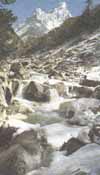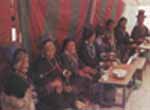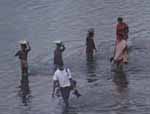
|
Himalayan Culture Group Lesson Plan This activity will help introduce us to some of the ways that humans interact with the environment of the Himalayan region. This idea originated with a lesson plan found on a CD-rom from the Society of American Archaeology along with some other curricular development ideas from Mimi Stephens of Clark University. For more lesson plans and educator resources in archaeology, visit http://www.saa.org/public/resources/foredu.html. They have some excellent teaching materials and resources. Gerrald Berreman’s article, “Cultures and People of the Himalayas” in Asian Survey 1963, pgs. 289-230 is useful as a framework for clarifying some of the various cultural distinctions. Objective: Introduce students to some of the cultural groups of the Himalayan region by having them work cooperatively to draw conclusions from artifacts. Time period: 45 minutes Materials: Various artifacts and pictures to represent the following cultural groups: Herders-yaks, sheep, goats Pashtos/Hunza-Islamic, artisan works, cattle, horses, sheep, goats Paharis-Sanskrit and other languages, Indian, Hindu, plow, bullock, rice, millet, wheat, barley, maize, and legumes Himalayan terrace farmers-terrace farming, stone houses, slate, wood, rice Plains people(terai)-water sources, mud brick homes, tiles, dung Bhotia-artifacts that show evidence of trade, Assamese-artifacts that show evidence of trade, slash and burn agriculture, ash, bamboo, rice, millet, maize, tubers, cattle, pigs, chickens, fish, weapons, bamboo mats, thatch, stone, hearth, long houses Resources: One idea is to cut pictures out of old magazines. National Geographic, animal, science, or Asian travel magazines may have pictures that you could use. I glue them into file folders and then laminate the file folder to reuse in the future. Another idea would be to create a technology photo gallery and have kids rotate around in a computer lab. You could also just hit up your kitchen cupboards, garage sales, or Goodwill stores to find some of the artifacts. For example, you could use pinto beans for legumes or sand for ash. Be creative. Procedure: 1. Arrange the artifacts, pictures, and materials representing each group in eight stations around the classroom. Set expectations for conversation, materials handling, movement, signal to move, group roles, etc. 2. Explain that each group (ideally, 8 groups of 3-4) will have three minutes at each station to look closely at and to touch the objects. 3. Tell students that the task is to draw conclusions about human environment interaction and some of the cultural groups in the Himalayan region. What do these people do to survive? What do they eat? Where do they live? How might these people use their environment? Your group should discuss answers to these questions. Take turns as the scribe for the group to record your group’s agreed upon conclusion on the paper provided. 4. Check for understanding and questions Assessment: Individual: Evaluate students on a three- point rubric through observation and oral assessment. 3- Proficiently identifies an interaction between a physical and human system 2-Partially discusses physical and human systems, but may not see the interaction between the two systems 1-Little to no discussion of the relationship between physical and human systems Group: Evaluate the group conclusions sheet for completion; evaluate group participation; use individual assessment rubric to evaluate group. Closure: Students should be able to discuss what they learned based on the following subobjectives:
|
This site was created by (insert name) at the NEH Summer Institute "Cultures and Religions of the Himalayan Region," held at the College of the Holy Cross, Summer 2006




